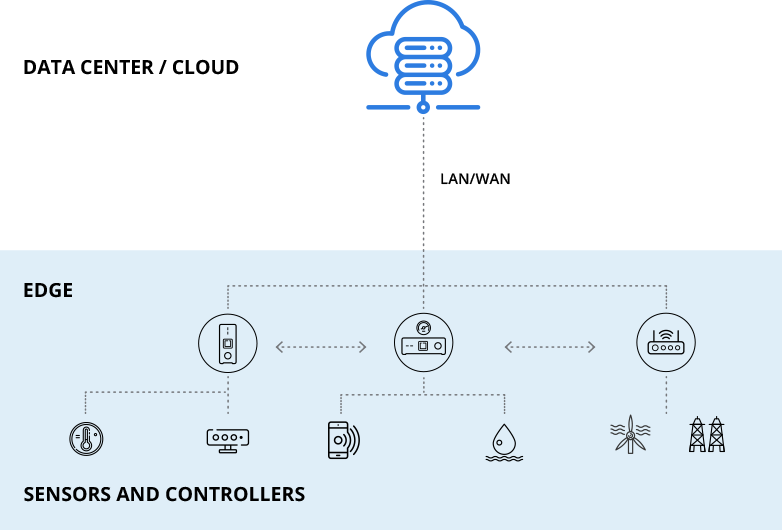What Is Edge Computing?
Edge computing (or IoT edge processing) refers to taking action on data as near to the source as possible rather than in a central, remote data center, to reduce latency and bandwidth use. By bringing computation to a network’s edge, businesses either filter/aggregate the raw data to reduce the amount that must be transmitted over the network, or they run analytics on-site to get important insights immediately. Both of these strategies help to reduce or remove the delay inherent in long-range data transmission.
-

Edge computing, sometimes referred to as IoT edge processing, moves compute power close to data sources rather than in a remote data center, to reduce latency and bandwidth consumption.
Why Does Edge Computing Matter?
Edge computing matters because it increases the speed and effectiveness at which businesses can respond to information. Consider the analysis of sensor data that is generated at a remote equipment site to monitor the status of the equipment. This type of “Industrial Internet of Things” (IIoT) environment can create thousands or millions of data points per second. Without the processing at the edge to filter data, it can be too slow and impractical to transmit all the raw data to a remote data center, especially if the network connectivity has slow/inconsistent bandwidth. In some cases, businesses without edge computing capabilities collect data in storage media and physically ship the media via trucks to the data center. This adds obvious latency that can result in missing the signals that equipment needs to be repaired or replaced immediately. With edge computing, much of this process could take place next to the sensors, dramatically reducing latency and/or bandwidth requirements for the business.
Edge computing is not always an obvious solution, as it has challenges that businesses need to address. One common constraint is limited physical space. Mobile data sources like vehicles do not have much space to allocate to computer hardware, and isolated sites like oil wells do not have the required infrastructure to run servers. To overcome space limitations, businesses can adopt an edge computing approach, which leverages specialized hardware servers that are designed for limited space and harsh, unprotected locations. One trade-off with that strategy is the lesser processing power available in the computers. This means that the software that processes the data must be optimized for lower-powered computers.
Another concern is data security, which pertains to the data being processed as well as the data being transmitted. Both software and hardware need to have built-in security capabilities, despite the processing power limitation.
Technologies designed for edge computing are gaining more attention due to the growth of IIoT. Edge-optimized software like the Hazelcast In-Memory Computing Platform enables lightweight, efficient, and secure deployments on computer servers of all sizes to handle a wide range of edge computing applications.
How Are IoT and Edge Computing Related?
Edge computing often implies an IoT environment, as IoT data is typically created in a remote location away from a central data center. As the number of smart, internet-connected things has exploded over the last decade, so has the amount of bandwidth they use. By deploying IoT edge processing capabilities near the sensors and devices, businesses can be quicker to respond to new data.
However, it does not always have to apply to IoT environments. In some cases, the entire processing (especially analytics) is done near the data source, so there is no need to transmit data across the internet to a data center. Even without internet connectivity, challenges such as space limitations, processing power limitations, and security requirements still apply.
What Are the Benefits?
In addition to the reduced latency that allows greater immediacy around analytics, edge computing can alleviate some challenges around data security and privacy. By distributing computing power to remote sites, businesses can reduce the impact of having all data in a central location. It also exposes less data transmitted over the internet. And in some regulated industries, businesses can address compliance and privacy regulations by not transmitting sensitive data over borders.
For businesses, another key benefit is that edge computing can lead to cost savings through reduced bandwidth. By processing data at the edge, an organization can ensure that it only pays to transmit and store its necessary, valuable data, while simply discarding its low-value data.